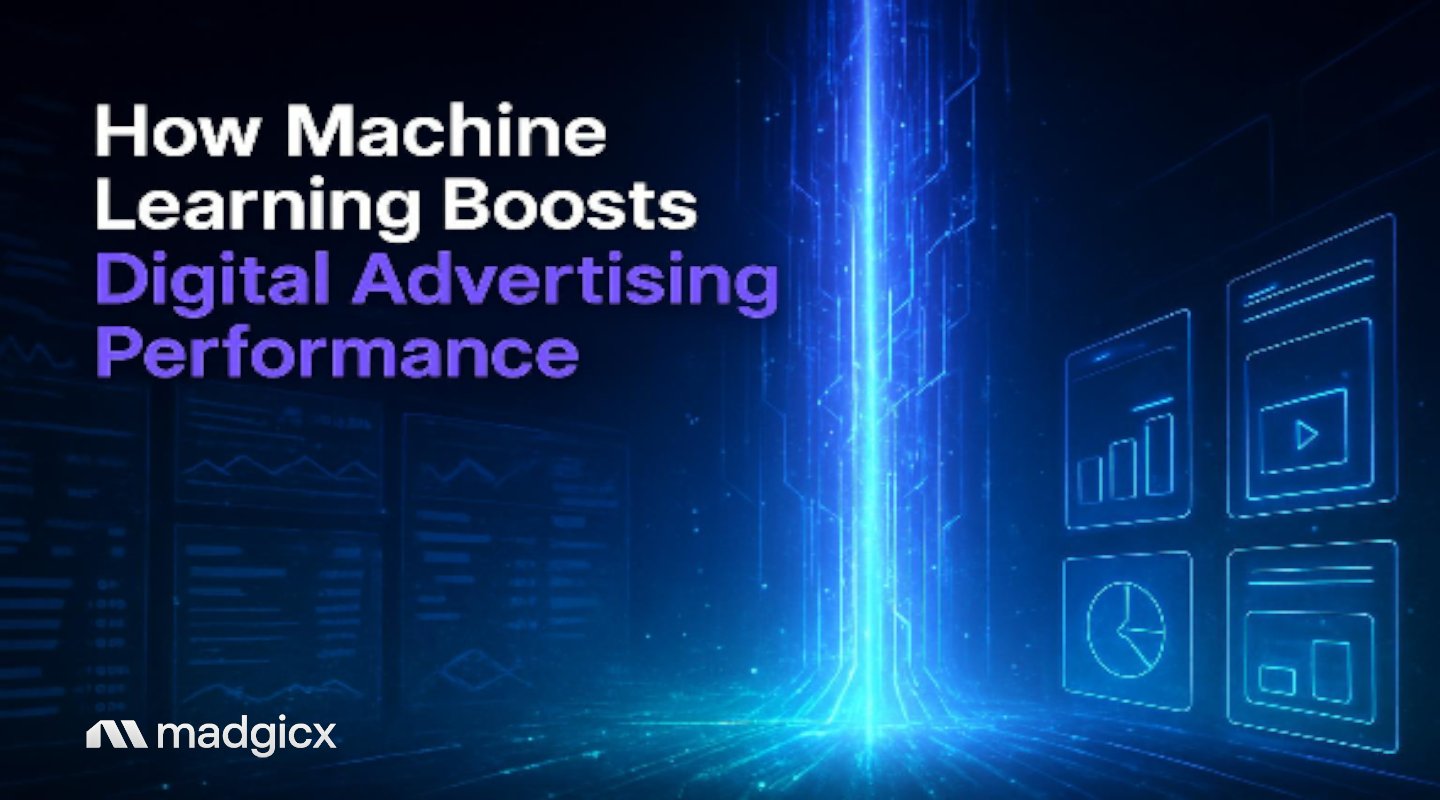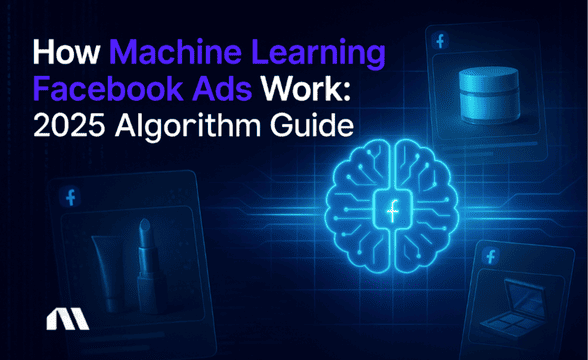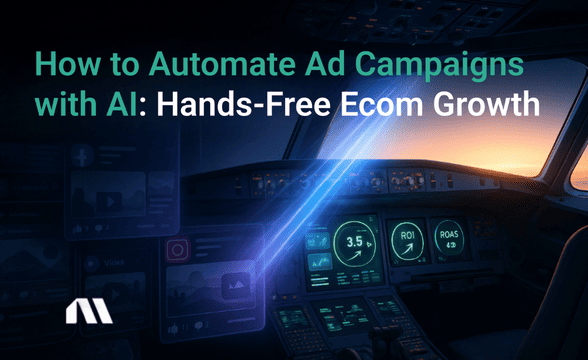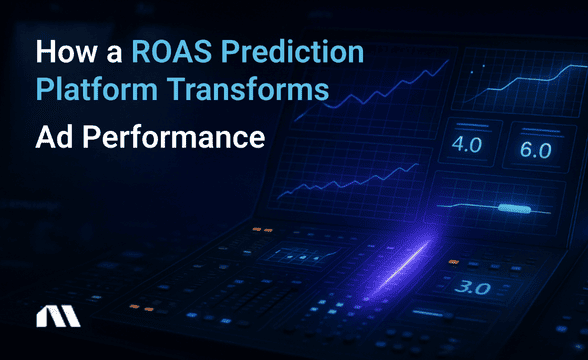Discover how machine learning transforms digital advertising performance with automated bidding, predictive targeting, and ROI optimization strategies for 2025.
Picture this: It's 2 AM, and you're hunched over your laptop, manually tweaking bid adjustments for what feels like the thousandth time this week. Your eyes are burning, your coffee's gone cold, and you can't shake the feeling that there's got to be a smarter way to optimize campaign performance.
Sound familiar?
Here's the thing – there absolutely is a better way, and it's already transforming how the most successful performance marketers operate. Machine learning in digital advertising platforms uses algorithms to analyze user data, predict behavior, and automatically optimize ad targeting, bidding, and creative delivery in real-time, designed to improve ROI, reduce costs, and enhance personalization at scale.
The numbers are compelling: AI campaigns can deliver up to 14% higher conversion rates compared to traditional manual optimization. But here's what most guides won't tell you – implementing machine learning in digital advertising platforms isn't about flipping a switch and hoping for the best.
It requires a strategic, platform-specific approach that balances automation with human insight.
That's exactly what we're covering in this complete implementation guide. You'll walk away with actionable strategies, platform-specific setups, and measurement frameworks that actually work in the real world of performance marketing.
What You'll Learn
Ready to revolutionize your advertising approach? Here's exactly what we're diving into:
- How to implement ML optimization strategies designed to improve and predict conversion rates
- Platform-specific automation setups for Facebook, Google, and programmatic advertising
- ROI measurement frameworks to quantify ML impact on your campaigns
- Advanced attribution modeling techniques for cross-platform performance tracking
- Bonus: Ready-to-use ML implementation checklist and ROI calculator
The Machine Learning Revolution in Digital Advertising Platforms
Let's cut through the hype and get to what machine learning in digital advertising platforms actually means for us performance marketers. At its core, ML in advertising is about pattern recognition at large scale.
While you're analyzing last week's data to make today's decisions, machine learning algorithms are processing millions of data points in real-time to optimize for tomorrow's opportunities.
The revolution isn't just happening – it's already here. According to recent industry research, 83% of senior brand marketers use AI to target digital ads, and the gap between early adopters and laggards is widening fast. 💰
Pro Tip: Start with platform-native AI tools before jumping into third-party solutions. Facebook's Campaign Budget Optimization and Google's Smart Bidding have years of data and integration advantages that external tools can't match initially.
What makes this particularly exciting for us is that ML doesn't just improve one metric – it creates a compound effect across your entire funnel. Better targeting leads to higher engagement, which improves your relevance scores, which reduces your costs, which allows for more aggressive scaling.
It's a virtuous cycle that traditional optimization simply can't achieve.
The competitive advantage is real and measurable. Early adopters aren't just seeing incremental improvements – they're fundamentally changing how they approach campaign management, moving from reactive optimization to predictive strategy.
5 Core ML Applications Every Performance Marketer Must Master
1. Automated Bid Optimization
Gone are the days of manually adjusting bids based on yesterday's performance. Modern machine learning algorithms analyze hundreds of variables in real-time – device type, time of day, user behavior patterns, competitive landscape, and even weather data – to determine the optimal bid for each auction.
The setup process varies by platform, but the principle remains consistent: define your target CPA or ROAS, set boundaries, and let the algorithm learn. Facebook's Campaign Budget Optimization redistributes budget across ad sets based on performance, while Google's Target CPA bidding adjusts bids to hit your cost-per-acquisition goals.
2. Predictive Audience Targeting
This is where machine learning in digital advertising platforms truly shines. Instead of targeting based on demographics or interests, predictive targeting identifies users most likely to convert based on behavioral patterns. Facebook's Lookalike Audiences and Google's Similar Audiences use ML to find users who share characteristics with your best customers.
The key is feeding these systems quality data. The more conversion data you provide, the better the algorithms become at identifying high-value prospects. Start with your highest-value customer segments and expand from there.
3. Dynamic Creative Optimization
Imagine having a creative team that works continuously, constantly testing new combinations of headlines, images, and calls-to-action. That's essentially what creative intelligence AI delivers.
These systems automatically test different creative elements and serve the best-performing combinations to each user segment. ✨
Facebook's Dynamic Ads and Google's Responsive Search Ads are entry-level examples, but advanced platforms can optimize across dozens of creative variables simultaneously.
4. Attribution Modeling
Traditional last-click attribution is dead in the water for performance marketers running cross-platform campaigns. ML-powered attribution models analyze the entire customer journey, assigning value to each touchpoint based on its actual influence on conversions.
This is particularly crucial in today's privacy-first environment. With iOS 14.5+ limiting pixel tracking, server-side attribution powered by machine learning becomes essential for accurate measurement.
5. Performance Forecasting
Predictive budget allocation takes the guesswork out of campaign planning. Instead of allocating budget based on historical performance, ML models predict future performance across different scenarios, helping you optimize budget distribution before campaigns even launch.
These forecasting models consider seasonality, competitive factors, and market trends to provide realistic performance projections that actually help with strategic planning.
Platform-Specific Implementation Strategies
Facebook/Meta: The Automation Powerhouse
Meta's machine learning capabilities have evolved dramatically over the past few years. Campaign Budget Optimization (CBO) is just the starting point. Here's your implementation roadmap:
Week 1-2: Foundation Setup
- Enable CBO at the campaign level for all new campaigns
- Implement Conversions API for improved data quality
- Set up Advantage+ Shopping campaigns for e-commerce
Week 3-4: Advanced Features
- Test Advantage+ Audience for prospecting campaigns
- Implement Dynamic Product Ads with ML-powered product recommendations
- Enable automatic placements across all Meta properties
Pro Tip: Don't disable learning phases prematurely. Meta's algorithm needs at least 50 conversions per week to optimize effectively. If you're not hitting this threshold, consider broader targeting or longer optimization windows.
Google Ads: Smart Bidding Mastery
Google's Smart Bidding strategies are among the most sophisticated ML implementations available to us advertisers. The key is choosing the right strategy for your goals:
- Target CPA: Best for lead generation and e-commerce with consistent conversion values
- Target ROAS: Ideal for e-commerce with varying product margins
- Maximize Conversions: Perfect for awareness campaigns with sufficient budget
- Maximize Conversion Value: Optimal for e-commerce focused on revenue growth
Implementation Timeline:
- Start with Target CPA or Target ROAS based on your primary KPI
- Allow 2-3 weeks for initial learning
- Gradually expand to Performance Max campaigns for maximum reach
Programmatic Platforms: RTB Optimization
Real-time bidding platforms offer the most granular ML control but require more technical expertise. Focus on these key areas:
- Audience Segmentation: Use ML to identify micro-segments within your target audience
- Frequency Optimization: Prevent ad fatigue through intelligent frequency capping
- Supply Path Optimization: Automatically identify the most cost-effective inventory sources
Quick Tip: Test one platform thoroughly before expanding. Master Facebook or Google's ML capabilities before adding programmatic complexity to your mix.
ROI Measurement and Attribution Frameworks
Here's where most of us performance marketers struggle – proving that machine learning in digital advertising platforms actually improves results. The challenge isn't just measurement; it's attribution in an increasingly complex, multi-touch customer journey.
Setting Up Proper Tracking
Your ML success depends entirely on data quality. Garbage in, garbage out applies more than ever when algorithms are making real-time optimization decisions. Here's your tracking foundation:
- Server-Side Tracking: Essential for iOS 14.5+ compliance and data accuracy
- Cross-Platform Attribution: Connect touchpoints across Facebook, Google, email, and organic channels
- Conversion Value Tracking: Beyond conversion counting – track actual revenue and lifetime value
The impact can be significant. AI can help reduce customer acquisition costs by up to 52% when proper attribution is in place, but only if you're measuring the right metrics. 🚀
Calculating Incremental Lift
This is where you prove ML's value to stakeholders. Set up proper test and control groups to measure incremental impact:
- Geo-Split Testing: Compare ML-optimized campaigns in different geographic regions
- Holdout Groups: Reserve 10-20% of budget for manual optimization as a control
- Time-Based Comparisons: Measure performance before and after ML implementation
Madgicx's cross-platform attribution dashboard makes this process significantly easier by automatically calculating incremental lift across all your advertising channels. Instead of manually piecing together data from multiple platforms, you get a unified view of how ML impacts your entire funnel.
Advanced Metrics Beyond ROAS and CPA
Traditional metrics tell part of the story, but ML optimization requires more sophisticated measurement:
- Customer Lifetime Value (CLV): ML's impact on long-term customer value
- Incremental Reach: New customers acquired through ML optimization
- Cross-Channel Attribution: How ML on one platform affects performance on others
- Efficiency Metrics: Time saved through automation and improved decision-making
The key is establishing baseline metrics before implementing ML, then tracking improvements across multiple dimensions. Companies with AI investments can see 10-20% higher ROI specifically because they measure beyond surface-level metrics.
Advanced Optimization Techniques
Ready to take your machine learning in digital advertising platforms implementation to the next level? These advanced techniques separate the pros from the amateurs.
Multi-Armed Bandit Testing for Creative Rotation
Traditional A/B testing is too slow for the modern advertising environment. Multi-armed bandit algorithms automatically allocate more traffic to better-performing creatives while continuing to test new variations. This approach can improve creative performance by 15-30% compared to static rotation.
The setup requires platforms that support dynamic creative allocation – Facebook's Dynamic Creative and Google's Responsive Ads are starting points, but advanced AI advertising platforms offer more sophisticated implementations.
Ensemble Modeling for Audience Optimization
Instead of relying on a single ML model, ensemble approaches combine multiple algorithms to improve prediction accuracy. This technique is particularly powerful for audience targeting, where different models might excel at identifying different customer segments.
The practical application involves running multiple targeting strategies simultaneously and using ML to determine optimal budget allocation across each approach. It's complex but delivers measurably better results for large-scale campaigns.
Real-Time Budget Reallocation Strategies
Static budget allocation is dead. Modern advertising real-time decision-making systems continuously monitor performance across campaigns, ad sets, and even individual ads, automatically shifting budget toward the highest-performing elements.
This goes beyond basic CBO. Advanced systems consider factors like:
- Time-of-day performance patterns
- Competitive landscape changes
- Seasonal trends and market conditions
- Cross-platform performance correlations
Privacy-First ML Approaches for iOS 14.5+ Compliance
The iOS 14.5 update fundamentally changed how we approach machine learning in digital advertising platforms. Privacy-first optimization requires new strategies:
- Aggregated Event Measurement: Optimize for broader conversion categories rather than specific events
- Modeling-Based Attribution: Use statistical models to estimate conversion impact
- First-Party Data Integration: Leverage customer data for improved targeting accuracy
The most successful performance marketers have adapted their ML strategies to work within these privacy constraints while maintaining optimization effectiveness.
Implementation Roadmap and Best Practices
Let's get tactical. Here's your step-by-step roadmap for implementing machine learning in digital advertising platforms across your advertising operations:
Days 1-30: Foundation Phase
Week 1: Data Audit and Setup
- Audit current tracking implementation
- Implement server-side tracking where needed
- Establish baseline performance metrics
- Document current optimization processes
Week 2: Platform Selection and Initial Setup
- Choose primary platform for ML implementation (we recommend starting with your highest-spend platform)
- Enable basic ML features (CBO, Smart Bidding, etc.)
- Set up proper conversion tracking and attribution
Week 3: First ML Campaign Launch
- Launch test campaigns with ML optimization enabled
- Maintain control groups for comparison
- Begin daily monitoring and documentation
Week 4: Initial Optimization and Learning
- Analyze early performance data
- Make necessary adjustments to targeting and bidding strategies
- Document lessons learned and optimization opportunities
Days 31-60: Expansion Phase
Weeks 5-6: Scale Successful Strategies
- Increase budget for top-performing ML campaigns
- Expand successful strategies to additional campaigns
- Begin testing advanced ML features
Weeks 7-8: Multi-Platform Integration
- Implement ML on secondary advertising platforms
- Set up cross-platform attribution and measurement
- Begin testing AI tools for advertising automation
Days 61-90: Optimization Phase
Weeks 9-10: Advanced Feature Implementation
- Deploy sophisticated ML features (ensemble modeling, advanced attribution)
- Implement automated reporting and alerting systems
- Begin training team members on ML optimization techniques
Weeks 11-12: Performance Analysis and Strategy Refinement
- Conduct comprehensive performance analysis
- Refine ML strategies based on 90-day results
- Plan next phase of ML implementation
Common Pitfalls and How to Avoid Them
Pitfall #1: Impatience with Learning Phases
Most of us expect immediate results from ML implementation. Reality check: algorithms need time and data to optimize effectively. Give new campaigns at least 2-3 weeks before making major changes.
Pitfall #2: Over-Optimization
The temptation to constantly tweak ML settings is strong, but it's counterproductive. Frequent changes reset learning phases and prevent algorithms from reaching optimal performance.
Pitfall #3: Ignoring Data Quality
Machine learning in digital advertising platforms is only as good as the data it receives. Poor tracking implementation, incomplete conversion data, or inconsistent attribution will sabotage even the best algorithms.
Pro Tip: Maintain human oversight for strategic decisions. ML excels at tactical optimization but still requires human judgment for creative strategy, audience insights, and campaign planning.
Team Training and Skill Development
Successful ML implementation requires upskilling your team. Focus on these key areas:
Technical Skills:
- Platform-specific ML feature training
- Attribution modeling and measurement
- Data analysis and interpretation
Strategic Skills:
- Campaign planning with ML considerations
- Creative strategy for automated optimization
- Performance analysis and optimization
Soft Skills:
- Patience with learning phases
- Data-driven decision making
- Collaboration between human insight and machine optimization
Future-Proofing Your ML Strategy
The advertising landscape evolves rapidly, and your machine learning in digital advertising platforms strategy needs to evolve with it. Here's what's coming and how to prepare:
Emerging Trends in Advertising AI
- Generative AI for Creative: AI-generated ad creative is moving beyond simple text to sophisticated image and video generation. Early adopters are already testing AI-generated product images and video ads with promising results.
- Predictive Customer Lifetime Value: Advanced ML models are getting better at predicting not just immediate conversions but long-term customer value, enabling more sophisticated bidding strategies.
- Cross-Platform Optimization: The future belongs to ML systems that optimize across all advertising channels simultaneously, rather than platform-specific optimization.
Privacy Regulation Adaptations
Privacy regulations continue evolving, and your ML strategy must adapt:
- First-Party Data Emphasis: ML systems increasingly rely on first-party customer data rather than third-party tracking
- Consent-Based Optimization: Future ML implementations will need to work within explicit user consent frameworks
- Aggregated Learning: Privacy-preserving ML techniques that optimize without accessing individual user data
Platform Evolution Predictions
- Increased Automation: Expect platforms to automate more aspects of campaign management, from creative generation to audience targeting
- Better Attribution: Cross-platform attribution will improve as platforms develop better data-sharing agreements
- Simplified Interfaces: As ML handles more optimization tasks, platform interfaces will focus more on strategy and less on tactical management
The key to future-proofing is building flexible systems that can adapt to platform changes while maintaining optimization effectiveness.
Frequently Asked Questions
How long does it take to see results from machine learning in digital advertising platforms implementation?
Most of us performance marketers see initial improvements within 2-3 weeks, but significant results typically emerge after 30-45 days. The timeline depends on your conversion volume – platforms need sufficient data to train their algorithms effectively. If you're generating fewer than 50 conversions per week, expect longer learning periods.
What's the minimum budget needed for effective ML optimization?
There's no universal minimum, but practical thresholds exist. Facebook recommends at least $50-100 daily budget per ad set for effective ML optimization. Google's Smart Bidding works with smaller budgets but performs better with $1,000+ monthly spend per campaign. The key is generating enough conversion data for algorithms to learn from.
How do I maintain control while using automated systems?
Set clear boundaries and monitoring systems. Use bid caps, budget limits, and audience restrictions to prevent runaway spending. Implement automated alerts for significant performance changes. Most importantly, maintain strategic oversight – let ML handle tactical optimization while you focus on creative strategy, audience insights, and campaign planning.
What happens to my campaigns if ML algorithms change?
Platform algorithm updates are inevitable, but you can minimize disruption. Diversify across multiple platforms and optimization strategies. Maintain detailed performance documentation to quickly identify algorithm-related changes. Keep some manual campaigns as backup options. Most algorithm updates improve performance over time, but having contingency plans reduces risk.
How do I prove ML ROI to stakeholders?
Use incremental lift measurement with proper test and control groups. Set up geo-split tests or holdout groups to isolate ML impact. Track multiple metrics beyond ROAS – include efficiency gains, time savings, and improved customer acquisition quality. Document the compound benefits: better targeting leads to higher engagement, which improves relevance scores and reduces costs.
Your Next Steps to ML-Powered Performance
We've covered a lot of ground, but implementation success comes down to four key priorities:
1. Start with Data Foundation: Ensure your tracking and attribution systems can support ML optimization. Poor data quality will sabotage even the best algorithms.
2. Choose Your Primary Platform: Don't try to implement machine learning in digital advertising platforms everywhere at once. Master one platform's capabilities before expanding to others.
3. Embrace the Learning Phase: Give algorithms time to optimize. Impatience is the biggest killer of ML success.
4. Measure What Matters: Set up proper measurement frameworks to prove ML impact and guide optimization decisions.
Your specific next step? Pick your highest-spend advertising platform and enable its native ML features this week. Whether that's Facebook's Campaign Budget Optimization, Google's Smart Bidding, or another platform's automation tools, the key is starting with proven, platform-native solutions.
The advertising landscape is evolving rapidly, and studies show up to 20% increase in conversion rates and 30% increase in ROAS with AI-powered programmatic isn't just possible – it's becoming the baseline expectation.
Platforms like Madgicx combine multiple ML capabilities in one dashboard, making implementation faster and measurement clearer for performance marketers who want to stay ahead of the curve.
The future of advertising performance is automated, predictive, and incredibly powerful. The question isn't whether you'll adopt machine learning in digital advertising platforms – it's whether you'll be an early adopter or play catch-up. Start your ML journey today, and transform those late-night optimization sessions into strategic planning time while AI assists with optimization tasks.
Transform your advertising performance with advanced machine learning algorithms that help optimize Meta bids, audiences, and creatives, primarily focused on Meta advertising. Our AI Marketer provides 24/7 optimization recommendations, reducing manual work so you can focus more on strategy while AI assists with better results.
Digital copywriter with a passion for sculpting words that resonate in a digital age.







.avif)







